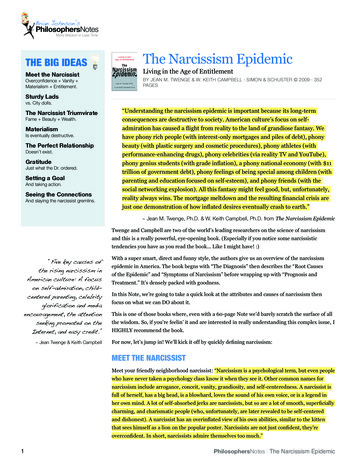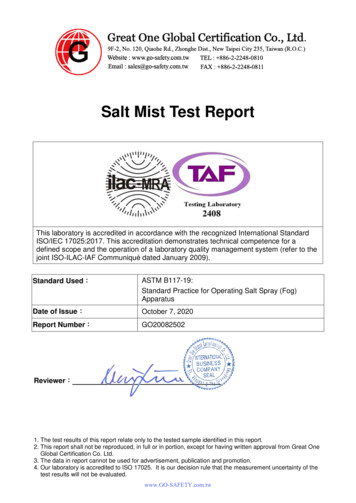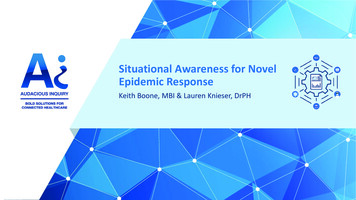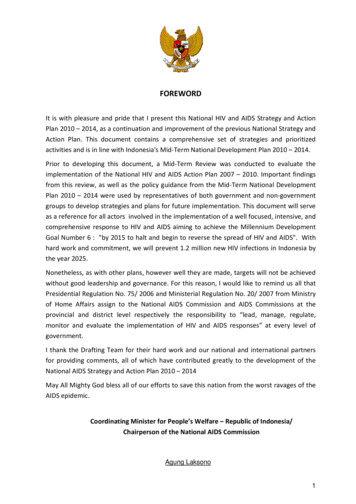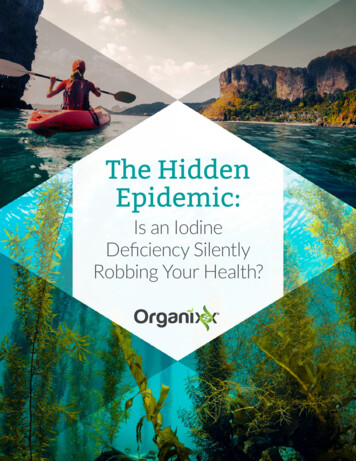
Transcription
The HiddenEpidemic:Is an IodineDeficiency SilentlyRobbing Your Health?
ContentsThe ProblemsIodine Deficiency Is a Worldwide Epidemic . 1Iodine RDA: A Brief History . 2Subclinical Iodine Deficiency: Where the Real Problem Lies . 33 Reasons Why Most People Are Iodine Deficient . 4What Are the Signs of Iodine Deficiency? . 9Iodine and the Thyroid . 10Hashimoto’s Thyroiditis . 11Hypothyroidism in Men . 12Iodine and the Reproductive System . 13Iodine and Fertility . 15Can a Person Have Too Much Iodine? . 16What About Hyperthyroidism and Iodine? . 17The SolutionsTesting Your Iodine Levels . 18You’ve Got Your Test Results: Now What? . 209 More (Little Known) Benefits of Iodine . 24Food Sources of Iodine . 27The Best and Worst Iodine Supplements . 28What’s Next? Creating Your Plan of Action . 32Organixx Iodine. 33Our Commitment to You. 34Sources . 35
Copyright 2020 · OrganixxNOTICE OF RIGHTS:All rights reserved. No portion of this publication may be reproduced, stored in a retrieval system,or transmitted in any form or by any means electronic, mechanical, photocopying, or otherwise,except by the inclusion of brief quotations in a review to be printed or published on the web, withoutpermission from Organixx.DISCLAIMER:The information and statements contained herein have not been evaluated by the FDA and are notintended to diagnose, treat, cure, or prevent any illness. The contents of this publication are forinformational purposes only and are not intended to be a substitute for medical advice, diagnosis,or treatment. Never disregard professional medical advice or delay seeking treatment due toinformation contained herein. You should take no action solely on the basis of this publication’scontents. Any action you take on the basis of the information provided is solely at your own riskand expense.FOLLOW USON FACEBOOKFIND USON YOUTUBESUBSCRIBE TOOUR PODCAST
The ProblemsIodine Deficiency Is a Worldwide EpidemicYou may think that since iodine is in most table salt these days that iodinedeficiency is a thing of the past. You may have even been told by your doctornot to worry about your iodine levels. But nothing could be further from thetruth. Now more than ever before, iodine deficiency is a problem worldwide– including in the U.S.Here’s a fact that not many doctors share with their patients – of all the essential substances the body must have in order to maintain optimal health,iodine may be the most important.“Let’s do the basics,” says Dr. David Brownstein, MD, one of the foremostexperts on iodine and author of Iodine: Why You Need It, Why You Can’t LiveWithout It.1 “To supply the body with the things it needs to function optimally.we supply the body with the right nutrients [and] it should be fine for a lifetime.I consider one of the basics iodine. Every cell in the body requires iodine tofunction optimally. We cannot function optimally in an iodine deficient condition.” 2Brownstein says that, along with his research partner, he has tested about6,000 individuals for basic iodine levels. Of that vast number, approximately96% have been low in iodine.This percentage is surprising, but it is not abnormal. According to the WorldHealth Organization (WHO), approximately two billion individuals worldwideare iodine deficient.3 In the U.S., the percentage could well mimic Brownstein’sfindings.At the same time, government public relations campaigns and a seriouslyoutdated U.S. RDA (Recommended Daily Allowance, now called the DietaryReference Intake,4 or DRI) paint an “all is well” picture about iodine in Americathat is dangerously misleading.The bottom line is this: making sure you and your family are getting enoughiodine from quality sources every day is something you need to be thinkingabout.1
Iodine RDA: A Brief HistoryThe current RDA for iodine was set forth by the U.S. National Institutes of Medicine in the 1940sfor a specific purpose. Prior to this time, large swaths of the U.S., especially in the Great Lakes,Northwestern, and Appalachian areas (as well as a large part of Canada) were known as the “GoiterBelt.” 5 This is because populations there were suffering from the most severe consequences ofiodine deficiency. In fact, a 2012 report put out by Boston Medical Center states that in the 1920s,between 26-70% of children in that area had a “clinically apparent goiter.”6 [Note: a goiter is a swelling on the neck caused by an enlarged thyroid gland.]To alleviate this problem, the introduction of iodized salt in the Goiter Belt began in earnest in themid-1920s. By the early 1950s, 60-70% of all American households used iodized salt exclusively.Now, the WHO’s International Council for the Control of Iodine Deficiency Disorders estimates thatroughly 90% of all American households have access to iodized salt and use it on a regular basis.7This all sounds like it is a “problem solved” when it comes to iodine, right? However, things are notalways so cut and dried when it comes to public health policy in America.2
Subclinical Iodine Deficiency:Where the Real Problem LiesThe RDA for iodine that was established in the 1940s isstill in effect today. It is:8 150 micrograms daily for adults 220 micrograms daily for pregnant women 290 micrograms daily for lactating womenThese RDAs were designed over 75 years ago, specificallyto prevent goiter and other complications that can arisebecause of iodine deficiency in pregnant women. They donot take into consideration the laundry list of health complications that can result from “subclinical iodine deficiency,” nor the increasing environmental factors that arecurrently affecting iodine uptake on a worldwide scale.In fact, subclinical deficiencies are a little-known but widespread problem for a number of essentialvitamins and minerals, including iodine. Unlike overt deficiency of a nutritional substance, subclinicalmalnutrition is revealed via subtle biochemical changes, at least at first. If left untreated, subclinicaldeficiencies can often lead to clinical malnutrition and higher risk for many diseases.A classic example of this can be seen with vitamin C. The RDA for this essential vitamin is 60 milligrams daily, the amount needed to prevent scurvy. But for the last 20 years or more, nutritionalinstitutions such as the Linus Pauling Institute have been recommending at least twice that amountfrom vitamin C-rich foods and supplements in order to increase antioxidant load and help preventchronic illnesses such as cancer and cardiovascular disease.9So, what about subclinical iodine deficiency? There is clear evidence that America can be countedamong the countries in which subclinical as well as overt iodine deficiency levels have reachedepidemic proportions.The biggest clue to this can be seen in the National Health and Nutrition Examination Surveys(NHANES) I (1971-1974) and III (1988-1994), conducted by the U.S. Centers for Disease Control.Between the first NHANES study and the third, the average concentration of iodine in urine decreased by 50% in the U.S. At the same time, iodine levels below 5 micrograms/dL (deciliter) increased four-fold. And the problem isn’t going away. CDC researchers found no change in iodinedeficiency levels between NHANES III and NHANES IV.103
3 Reasons Why Most People Are Iodine DeficientThere are multiple factors that have led up to the situation we are in today. In this report, we revealthree key factors, and offer solutions to help you turn a potential iodine deficiency around. As anyonesuffering from the symptoms of an underactive thyroid knows, getting back into balance can literallygive you your life back. Not to mention that it can support long-term disease healing and prevention.#1 Poor soil nutrient qualityIn addition to the historical miseducation regarding how much iodine our bodies actually need tofunction properly, another factor in the slow decline in iodine levels is the depletion of vital nutrientsin U.S. soil over the last 100 years. In fact, it was soil depletion in the Goiter Belt at the turn of thecentury which led to goiters and pregnancy complications 20 years later.The people living there were surrounded by farmers who grew spinach and cranberries,11 raisedlivestock for dairy products, and raised chickens for fresh eggs. These foods would normally havesupplied them with adequate amounts of iodine and other vital nutrients. Once their soil becamedepleted because of over-cultivation and lack of crop rotation, however, this was no longer the case.Of course, soil depletion did not just happen in the Goiter Belt — and it didn’t go away after the1940s. A multi-decade investigation conducted by the University of Texas studied over 40 commonvegetables and fruits grown in the U.S. between 1950 and 1999. Shockingly, the researchers foundstatistically significant declines of almost all essential vitamins and minerals in practically everycrop.124
#2 Lower salt consumption (and more toxins) starting in the 1970sAnother “one-two punch” happened in the 70s and 80s. These events contributed to lower iodinelevels overall.During this period, consumers began to respond to callsfrom allopathic (Western) health institutions and thesensationalized media to “cut the salt” because of newresearch which linked sodium to high blood pressure. Atthe same time, many health-conscious individuals beganavoiding iodized salt due to reports of manufacturersusing bleached sodium chloride, fluoride sodium bicarbonate, and other harmful chemicals in salt processing.Today, most people are aware of the importance ofhealthy sources of sodium for overall health. Sadly, industry practices that utilize harsh chemicals in commercialsalt production haven’t changed that much over the last50 years. Holistic experts still advise avoiding iodized saltat all costs and opting for Himalayan pink or Celtic seasalt instead.Most importantly, however, it was during the industrial boom of the 70s and 80s that the toxic loadgrew, especially in the U.S.13 High toxic load is a burden we all now carry. As careful as you may be inavoiding toxins, no one can completely avoid exposure to dangerous chemicals in the water, air, andsoil. Included in this toxic burden are specific environmental toxins which can affect iodine levelsdirectly by blocking iodine absorption.5
#3 Halide toxins that block iodineYou have likely heard about environmental toxins which are linked to serious diseases. But did youknow that there are specific toxins which block the absorption of iodine in your body?These iodine-targeting chemicals are called “halides” because they each contain a halogen atommixed with another element. In fact, iodine in its organic form is part of the halide group on the periodic table as well. This is why halide toxins – such as the ones mentioned below – are particularlydamaging.At the biochemical level, the body cannot differentiate between an iodine molecule and a bromidemolecule. When a rush of bromide (or chlorine or fluoride) chemicals enter the body, they will take upthe spaces within cellular receptor sites in the thyroid, the mammary glands and ovaries in women,the prostate glands in men, and in other locations of iodine uptake.Think of the situation as a rude driver in a busy parking lot. You know the scene. Here comes someone who barrels their way into the space you had your eye on and were just about to go into. Insideyour body, the “rude drivers” are fluoride, chlorine, and especially bromide. Let’s examine each inmore detail:BromideBromide is first on our list since bromide-induced thyroid dysfunction is on the rise. In addition, investigational evidence is increasingly concluding that it maybe a particularly aggressive toxic chemical when vyingfor common receptor sites in iodine-dependent glands.14Because bromide is cheap to produce, manufacturersfrom different industries are increasingly using it for everything from household paint and new car interiors topool and spa cleaning products. Bromide replaces iodinein the thyroid gland, which can lead to rapid-onset hypothyroidism and goiter.Excessive bromide can also lead to lower levels of much-needed iodine in the mammary glands andresult in increased kidney stress. Sadly for the American public, bread manufacturers began replacing iodine with a form of bromide called potassium bromate in breads and pastries starting in the1970s, since it makes a good (and very cheap) dough softener.156
FluorideFluoride has been pumped into the municipal watersupplies of many U.S. cities and towns since the 1960s.Today, 67% of the American population lives in areaswhere fluoridated water is the norm.16 Proponentsof this practice tout fluoride’s benefits for preventingtooth decay.17 What many don’t know, however, is thatfluoride can wreak havoc on the endocrine system, thebrain, and fertility.A 2015 study conducted by the Centre for Health Services Studies and the University of Kent inthe U.K. found that hypothyroidism was twice as high in areas where water was fluoridated versusnon-fluoridated areas. They also found that where fluoride levels were more than three milligramsper liter of water, hypothyroidism rose by about 30% across the board.18Fluoride also can calcify the pineal gland,19 a major component of the endocrine system responsiblefor melatonin synthesis.ChlorineChlorine is another substance that is part of the halidegroup, so the same rules about iodine blocking applyhere as well. Besides exposure through bleaching products, most individuals are exposed to chlorine throughtaking showers and baths using nonfiltered chlorinatedwater. Another source of exposure is swimming in heavily chlorinated swimming pools and lounging in chlorinated water in the jacuzzi.Exposure to chlorine from warm or hot water canbe extra dangerous since this toxin can be absorbedthrough the skin and the respiratory system, and thengo directly into the bloodstream.A joint study sponsored in part by the U.S. EnvironmentalProtection Agency (EPA) even found that children whoused swimming pools on a regular basis were moreprone to asthma.207
PerchloratePerchlorate is a man-made substance used by themilitary as well as the aerospace and agribusiness industries. It has many of the chemical characteristicsof organic halides and can produce the same iodineblocking effects on the thyroid and other areas of thebody. Jet fuel and many fertilizers contain perchlorate,making airborne exposure as well as perchlorate inwater sources a concern for all.A report published in Scientific American21 states thattraces of perchlorate can be found in the bloodstreamsof just about everyone on the planet. Another studyconducted by the University of California, Los Angeles,speculated that perchlorate exposure may lead to ahigher risk of autoimmune thyroid disease (Hashimoto’sor Graves’ disease).22All of the ways in which halides may affect us in our toxic world can be overwhelming. The good news,however, is that getting rid of them can be relatively simple. One such way is through increasingyour iodine levels. More information regarding protecting yourself from iodine-depleting halidescan be found in the SOLUTIONS section of this report.8
What Are the Signs of Iodine Deficiency?Iodine deficiency can affect you in dozens of ways since it plays a part in so many functions in thebody. Besides reproductive and endocrine support, it is a powerful antioxidant that helps the immunesystem, assists in maintaining strong teeth and bones, supports brain health and mood balancing,helps detoxification pathways, and is a powerful antiseptic and antifungal. In short, it is needed byevery cell in the body.So, how can you tell if you have aniodine deficiency? Here are just a fewpossible signs: Fatigue Low energy Mood swings “Brain fog” Poor memory Dry skin Hair loss Unexplained weight gain orinability to lose weight Sore throat that won’t go away Swelling in the neck Sensitivity to cold Gastric disorders (such as IBS) Heart palpitations Ovarian cysts and uterine fibroidsin women Prostate imbalance in men Autoimmune conditionsDo any of these symptoms apply to you? If so, besure to read on. Next up we will explore somespecific health conditions that are often directlyrelated to iodine deficiency.9
Iodine and the ThyroidYou may recognize that many of these iodine deficiency symptoms are the same as that of hypothyroidism (aka an underactive or sluggish thyroid). Iodine is the “food” for the thyroid. Not gettingenough iodine for this “master hormone processor” will lead to hypothyroidism, plain and simple.Key hormones such as thyroxine (T4) and triiodothyronine (T3) cannot be created without a properlyfunctioning thyroid. These hormones are vital to the body since they are two of the main regulatorsof your metabolism. Your thyroid cannot make T4 and T3 without iodine.Millions of people are feeling the effects of hypothyroidism in the U.S. today. According to theNational Thyroid Association, 12% of the U.S. population will develop a thyroid condition sometimein their lifetime.23 At this moment, roughly 20 million Americans suffer from some form of thyroiddisease – however, an estimated 60% don’t even know they have it!10
Hashimoto’s ThyroiditisMost experts, even within conventional medical science, now say that the majority of hypothyroid cases these days are really the autoimmune condition Hashimoto’s thyroiditis, also known aschronic lymphocytic thyroiditis or simply Hashimoto’s.24 In the U.S., there are approximately 200,000new documented cases of Hashimoto’s annually. According to the American Association of ClinicalEndocrinologists (AACE), 14 million Americans currently live with the condition.25Hashimoto’s is technically an autoimmune condition, which means that the immune system createsantibodies which interrupt important chemical signaling between the thyroid, the pituitary, and thehypothalamus. These signals are needed to produce the proper amounts of T3 and T4. Hashimoto’sis often discovered by blood tests which show elevated levels of TSH (thyroid stimulating hormone),as well as particular antibodies in the bloodstream.There is a lot of confusion out there around iodine’s role in Hashimoto’s, in part because there arestill a lot of factors scientific research does not know about autoimmune conditions in general, theimportance of iodine in the body in general, and how these element all relate to each other.Many people suffering from Hashimoto’s believe that iodine is the sole cause of their condition, butnothing could be further from the truth.The role that iodine plays in a personwho has Hashimoto’s is complicated andbeyond the scope of this report. However,it is a known fact that iodine deficiency isthe cause of the majority of hypothyroidconditions worldwide. And if it is nowknown that most hypothyroidism is in factHashimoto’s, then it follows that one ofthe fundamental causes of Hashimoto’s isiodine deficiency as well.That being said, when a person is dealingwith the myriad of imbalances and glandular inflammatory responses associatedwith Hashimoto’s, there may be several factors at play which need to be considered.11
Does this mean that individuals with Hashimoto’s should avoid iodine at all costs? No way! MostHashimoto’s experts recognize the importance of iodine for people with Hashimoto’s,26 but recommend “going slow” at first.Studies from as far back as the 1990s show that low-dose iodine supplementation for individualswith Hashimoto’s who were not on any other rebalancing protocols other than thyroid hormonetherapy was able to reduce thyroid antibody levels.27 Other studies show the importance of seleniumin providing needed support for iodine absorption.28 Studies also correlate the removal of halidetoxins like bromide to increased iodine absorption in general.It is essential that a person with Hashimoto’s work with a qualified healthcare professional whoknows the important role iodine plays in the body as well as how iodine works in combination withother supplements such as selenium.29 A well-informed professional will also encourage gentledetoxification from halide toxins, which we’ll discuss in the next section.Remember that high halide toxicity can block iodine absorption in the thyroid. The autoimmunecomponents of Hashimoto’s often affect detoxification pathways, so many Hashimoto’s suffererswill have high levels of bromide, fluoride, and chlorine, as well as a back-up of other toxins in theirsystem. For anyone with autoimmune disease, supporting the liver30 with herbs such as milk thistle31and going gluten-free32 are essential for recovering health.If you are suffering from hypothyroidism, or specifically Hashimoto’s, know that thousands of individuals have turned their condition around through dietary changes, supporting their detoxificationpathways, the right supplementation, and lifestyle changes such as reducing stress.Hypothyroidism in MenCurrent statistics state that women are five to eight timesmore likely to have hypothyroidism than men. However,this does not mean that men cannot be affected byhypothyroidism.Low iodine levels will affect a man’s thyroid in much thesame way it will a woman’s, but with a few key differences.Since the thyroid and its T3 and T4 hormones also regulateall other hormones, hypothyroidism in men can cause imbalances in testosterone levels. This situation, in turn, can leadto reduced levels of sex hormone-binding globulin (SHBG).Low SHBG can make a man more susceptible to a myriad ofother disease conditions.12
Iodine and the Reproductive SystemIt’s not just the thyroid that relies on iodine to do its job. Did you know that iodine is also housedin and used by the gut, brain, salivary glands, breast tissue, and the ovaries? Besides the endocrinesystem, the reproductive system absolutely needs iodine to function. Both women and men relyon iodine for gland nourishment and adequate functioning. Iodine deficiency in women has a morewidespread effect than in men, since a woman’s reproductive system is more complex.The evidence is clear. When a woman is iodine deficient, she opens herself up to greater risk for amyriad of reproductive disorders. Here is a rundown of a few of the most common ones:Fibroid tumorsIf you are a woman in your 30s or 40s and discover you have fibroidtumors, your gynecologist may dismiss them as simply “part of gettingolder.” They may tell you that the fibroids will probably disappear oncemenopause hits and to “just hang in there.”This reaction is typical in part because fibroids are so common. A 2003study conducted by the National Institute of Environmental HealthSciences found that 70% of white women and 80-90% of African Americanwomen in America will develop fibroids by the time they are 50.33What is common doesn’t necessarily indicate what should be considered normal or healthy, however.Although direct scientific evidence linking iodine deficiency to fibroids is scant, what is completelyclear is the link between fibroids and hypothyroidism.One Austrian study conducted in 2014 found older women of African heritage who had low thyroidfunction had larger fibroid tumors than those without hypothyroidism. Another study conductedby the Catholic University of Korea School of Medicine linked thyroid nodules with uterine fibroidsdirectly.34 The connection between higher estrogen and fibroids is well-documented as well.Adequate iodine supports thyroid function, which plays a part in regulating all hormones in someway. Getting enough iodine also supports estrogen balance in favor of the mildest form of estrogen,called estriol. The most aggressive form of estrogen, called estradiol (as well as estradiol-mimickingxenoestrogens created from environmental toxins35) is responsible for the estrogen imbalance thatcan lead to reproductive complications and disease.Of the three kinds of estrogen in the body, estriol is the kind you want to have the most. Maintainingbalanced iodine levels in your system can help you get there.13
Polycystic Ovary Syndrome (PCOS)PCOS is the formation of cysts on the ovaries, which can develop whenever hormone imbalance ispresent. It is caused by insulin resistance, obesity, genetics, and a host of other factors. PCOS canalso occur because of iodine deficiency. For women, the ovaries contain the second largest storeof iodine after the thyroid.36 Just like the thyroid, it is vital that the ovaries get enough iodine tomaintain balance.PCOS was first described in medical journals over 75 years ago. At that time, it was considered arare condition. Now one in 15 women will suffer from PCOS in their lifetime, according to a reportpublished in the Journal of Clinical Endocrinology & Metabolism.37Is it a coincidence that while cases of PCOS have skyrocketed, there is also an epidemic of iodinedeficiency in our world?Fibrocystic Breast DiseaseAlso called benign breast disease, this is a condition that occurs when hormonally influenced andbenign cysts develop in the breast tissue. The cysts, although not considered serious, can causepain and tenderness.Researchers have found clear evidence of the link betweenfibrocystic breast disease and low iodine levels. Studies overthe last 30 years have shown that aggressive estrogen stimulation caused by lack of iodine can cause “microcysts” in breasttissue.38Besides the thyroid and the ovaries, the breasts store and utilize large amounts of iodine. When levels are low, the breastscompete for limited stores with the thyroid since both use thesame iodine-transporting proteins.39 Hyperplasia, or increasedcell growth, can often result from iodine deficiency becausedeficiency can spur an increase in aggressive estrogens.In addition, iodine provides a big antioxidant boost for the mammary glands. When these glands areiodine deficient, the breast tissue can become susceptible to oxidation. Hyperplasia, lipid oxidation,and all the other immune and endocrine system complications which can occur with low iodine levelscreate a situation ripe for abnormal cell growth in the breasts.4014
Iodine and FertilityA 2018 study conducted by the National Institutes of Health looked at over 450 women in the U.S.who were attempting to become pregnant. For women with moderate to severe iodine deficiency,a whopping 46% were less likely to get pregnant than those who had sufficient iodine levels.41 Evenwomen with mild (i.e. subclinical) iodine deficiency had increased risk of infertility, according to leadresearcher Dr. James Mills of the U.S. National Institute of Child Health and Human Development.42Once a woman does get pregnant, her body’s need for iodine increases throughout her pregnancy.There is a reason why the CDC recommends a greater intake of iodine for women who are expecting. Iodine helps protect the mother against preeclampsia, extra sensitivities to toxins, and othercomplications that can affect the fetus and lead to obesity. Iodine also helps to protect the fetusfrom neurological complications.15
Can a Person Have Too Much Iodine?As with all nutrients, the right amount of iodine in the body is a balanced amount. Although theproblem for most individuals is lack of iodine, overdosing on it is possible and can have side effects.Getting your iodine levels tested is the best way to know where you stand and how you can achievebalance. It is also possible to take the wrong kind of iodine, with potentially devastating effects onyour health.Something to keep in mind is that any kind of “organic iodine” or “elemental iodine” should NOT beingested. This kind of iodine does not absorb into the system in a beneficial way and can burn tissueon contact. Other iodine sources that can cause negative effects when taken in excess are Pimasyrup, radioactive iodine used in medical tests or sometimes for thyroid disease, Lugol’s solution,and large amounts of potassium iodide from kelp.In addition, some studies have linked high amounts of “iodate” found in table salt with gastrointestinal disturbance. Other symptoms of iodine overdose from these sources include stomach pain,dizziness and delirium, v
“Let’s do the basics,” says Dr. David Brownstein, MD, one of the foremost experts on iodine and author of Iodine: Why You Need It, Why You Can’t Live Without It. 1 “To supply the body with the things it needs to function optimally. we supply the body with th


